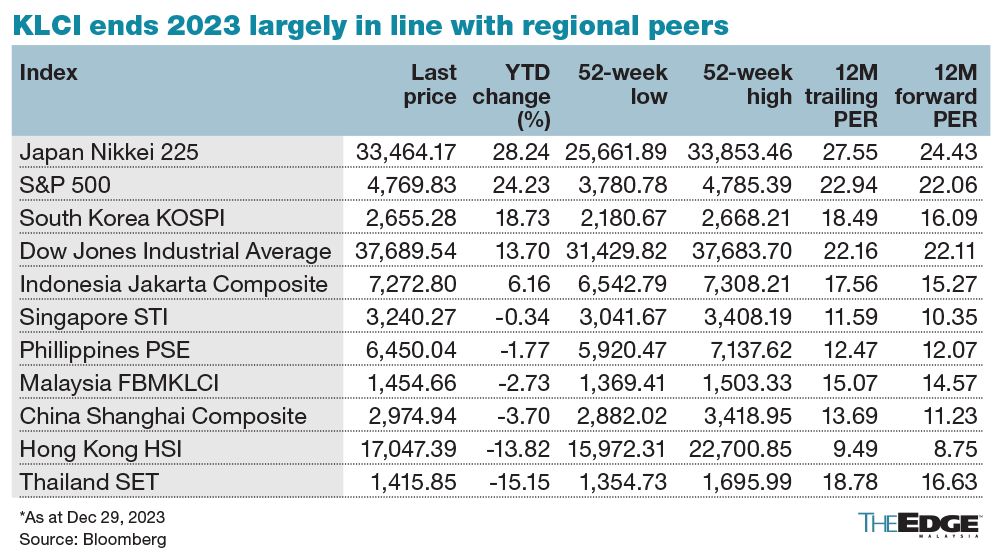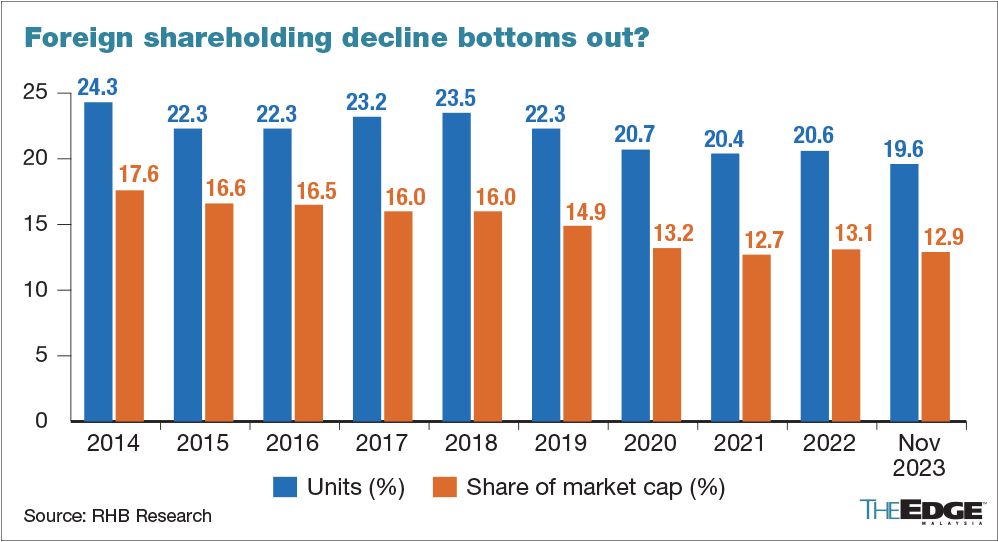Hope Rises for KLCI to Reverse Its Long-term Downtrend
edgeinvest
Publish date: Fri, 16 Feb 2024, 01:20 PM
KUALA LUMPUR (Feb 16): After a lacklustre 2023, the FBM KLCI rallied in the first six weeks of 2024, jumping over 5% to break past the 1,500 psychological resistance level, making it the second-best performer in the region year to date.
The local bourse's bellwether hit 1,531.37 on Tuesday, its highest since June 2022, largely due to the gains made by YTL Power International Bhd, Tenaga Nasional Bhd, Malayan Banking Bhd and CIMB Group Holdings Bhd, as the local stock market saw a surge in trading activities, with daily trading volume jumping past five billion shares on several occasions in the past few weeks alone. The threshold was only breached six times over the past two years.
The index has stayed firmly above the 1,500 points for over four weeks now — it closed at 1,528.38 points on Thursday — and market watchers have attributed the jump in trading volume to foreign investors entering the market.
In contrast, the FBM KLCI only briefly closed above the 1,500 level once, in mid-January 2023. The benchmark index averaged less than 1,440 for the year amid a more-hawkish-than-expected US Fed to China’s disappointing post-pandemic recovery. It ended 2023 at 1,455 points after dropping 2.73%, putting the local bourse's performance behind Indonesia’s Jakarta Composite (6.16%), Singapore’s STI (-0.34%) and Philippines' PSE (-1.77%), only beating Thailand’s SET (-15.15%).
The KLCI has now posted annual declines for eight out of the last 10 years — with 2017 and 2020 being the exceptions — with the drop in 2023 marking its third consecutive year of decline.
Is the trend set to reverse in 2024?
'Much of the bad news already priced in'
Market watchers are largely positive it would be a better year for the local bourse, with RHB Research summing it up as one where there are “more reasons to be optimistic on the outlook for 2024, with much of the bad news already priced in”.
Forecasts range from as bullish as a 20.6% gain to 1,755 points, to as modest as a 3.8% increase to 1,510.
Their optimism stems from the US Federal Reserve’s anticipated dovish pivot, China’s expected economic comeback and a stronger domestic economy. The latter is expected to be boosted by higher tourist arrivals, a further revival of exports, and diminishing political uncertainty.
While disappointing in terms of the local bourse's performance, 2023 closed on a more positive note as the Fed signalled that there could be three rate cuts totalling 75 basis points (bps) in 2024.
That, coupled with the anticipation that Bank Negara Malaysia would keep the overnight policy rate (OPR) unchanged at 3%, could make Malaysia more attractive than it has been over the past year to foreign investors, according to Areca Capital Sdn Bhd CEO Danny Wong.
With the KLCI’s undemanding valuation — based on consensus price-to-earnings of 14.6 times for 2024 and 12.5 times for 2025, versus the five-year average of 17.5 times — and the US dollar's strength expected to subside a little, Wong said foreign inflows may increase.
As such, there is expectation that the local bourse’s foreign shareholding, which has been sliding over the past decade, has likely bottomed out last year at 19.6% of the market's total value as at end-November.
An expected improvement in corporate earnings will also entice more foreign capital bakck to the local market, according to Rakuten Trade equity research vice-president Thong Pak Leng.
Consensus forecasts are projecting the KLCI’s earnings to grow 12.3% year-on-year (y-o-y), said MIDF Research, which is expectating the stocks under its coverage to see an average 13.2% climb increase in earnings.
The projected earnings growth is premised on headwinds ebbing due to declining price pressure, the expected interest rate downcycle and improvement in external trades, said MIDF Research.
Eye on geopolitical tensions, China recovery
Investors tend to dump emerging market equities at the beginning of Fed rate upcycles and turn buyers when rates peak.
But geopolitical tension and domestic political stability could hinder inflows to EMs, said Kenanga Research.
For 2024, it sees “a strong case for investors to return to EMs assuming China’s economy and the conflict in the Middle East (Israel-Hamas war) would gradually stabilise.”
China’s economic recovery remains focal as it will introduce tailwinds to commodities like industrial and base metals, according to RHB, as well as benefit emerging markets from the stronger trade and tourism prognosis.
RHB expects China’s accelerated growth momentum that was seen in 3Q2023 to persist in the next six to 12 months, as it observes a broad recovery in several sectors, including investment, industrial production and retail sales.
But despite the early signs of China's economic recovery, analysts are calling for optimism to be tempered with caution amid the country’s persistent real estate woes and continued risks of corporate defaults.
HLIB, on the other hand, expects China’s economic growth to continue to ease, dragged by risks from its property slump.
Malaysia 'doesn't stand out' relative to its peers
While market watchers agree that foreign investors are set to return to EMs on the back of the US Fed halting its historic rate upcycle, HSBC Global Research head of equity strategy Herald van der Linde expects that to only translate into a modest upside for Malaysia's stock market — with the KLCI forecast to grow only 4% to 1,510 points by end-2024 — as the country “doesn’t stand out” relative to its regional peers.
The brightest spot in the local bourse, according to HSBC, lies with companies with exposure to the semiconductor sector, due to the persistent trade tensions between US and China.
The bank also holds a conservative view on the Fed’s dovish pivot. Compared with the wider market’s expectations for the Fed to cut the federal funds rate (FFR) five to six times at 25 bps each from as early as March, HSBC is forecasting only three cuts for the year, starting from June.
Based on HSBC’s forecast, the FFR-OPR differential would fall to 1.5% — as opposed to consensus expectations of 0.75%-1% — from 2.25% currently, which it views as still insufficient to tame the US dollar's strength.
Source: TheEdge - 16 Feb 2024
Related Stocks
| Chart | Stock Name | Last | Change | Volume |
|---|
Market Buzz
2024-07-03
CIMB2024-07-03
YTLPOWR2024-07-02
CIMB2024-07-02
CIMB2024-07-02
CIMB2024-07-02
CIMB2024-07-02
CIMB2024-07-02
CIMB2024-07-02
CIMB2024-07-02
CIMB2024-07-02
MAYBANK2024-07-02
MAYBANK2024-07-02
TENAGA2024-07-02
TENAGA2024-07-02
TENAGA2024-07-02
TENAGA2024-07-02
TENAGA2024-07-02
TENAGA2024-07-02
TENAGA2024-07-02
TENAGA2024-07-02
TENAGA2024-07-02
TENAGA2024-07-02
TENAGA2024-07-02
TENAGA2024-07-02
TENAGA2024-07-02
YTLPOWR2024-07-02
YTLPOWR2024-07-01
CIMB2024-07-01
CIMB2024-07-01
CIMB2024-07-01
MAYBANK2024-07-01
MAYBANK2024-07-01
TENAGA2024-07-01
TENAGA2024-07-01
TENAGA2024-07-01
TENAGA2024-07-01
TENAGA2024-07-01
TENAGA2024-07-01
TENAGA2024-07-01
TENAGA2024-07-01
TENAGA2024-07-01
TENAGA2024-07-01
YTLPOWR2024-07-01
YTLPOWR2024-06-28
CIMB2024-06-28
CIMB2024-06-28
CIMB2024-06-28
CIMB2024-06-28
CIMB2024-06-28
CIMB2024-06-28
CIMB2024-06-28
CIMB2024-06-28
CIMB2024-06-28
CIMB2024-06-28
CIMB2024-06-28
MAYBANK2024-06-28
MAYBANK2024-06-28
TENAGA2024-06-28
TENAGA2024-06-28
TENAGA2024-06-28
TENAGA2024-06-28
TENAGA2024-06-28
TENAGA2024-06-28
TENAGA2024-06-28
TENAGA2024-06-28
TENAGA2024-06-28
YTLPOWR2024-06-27
CIMB2024-06-27
CIMB2024-06-27
CIMB2024-06-27
CIMB2024-06-27
CIMB2024-06-27
MAYBANK2024-06-27
MAYBANK2024-06-27
TENAGA2024-06-27
TENAGA2024-06-27
TENAGA2024-06-27
TENAGAMore articles on CEO Morning Brief
Created by edgeinvest | Jul 03, 2024
Created by edgeinvest | Jul 03, 2024
Created by edgeinvest | Jul 03, 2024
Created by edgeinvest | Jul 03, 2024
Created by edgeinvest | Jul 03, 2024
Created by edgeinvest | Jul 03, 2024
Created by edgeinvest | Jul 03, 2024

















